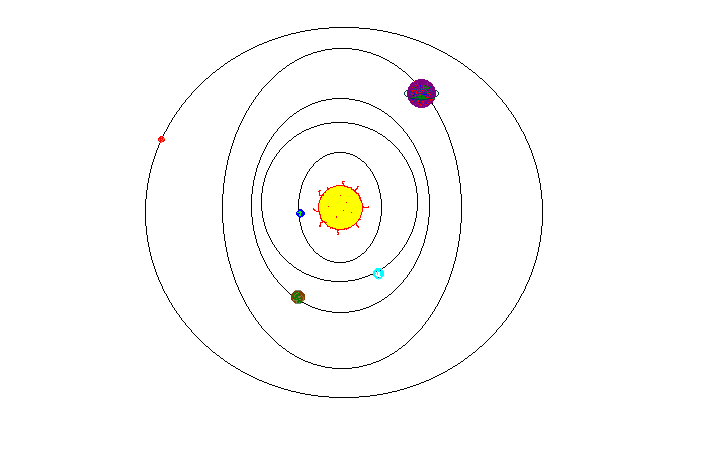
The Solar System
By: Steven Olin

|
Planet Name |
Mass (kg) |
Radius of Planet (m) |
Distance From Sun (m) |
Weight of 60kg man (N) |
Acc. due to Gravity (m/s2) |
Time for object to fall 100m (sec.) |
Period of Planetís Rotation (years) |
|
Gemelas |
2.2 x 1025 |
9.1 x 106 |
5.1 x 1010 |
1060 |
17.7 |
3.4 |
0.20 |
|
Thalassa |
6.8 x 1025 |
1.1 x 107 |
5.7 x 1010 |
2250 |
37.5 |
2.3 |
0.23 |
|
Theta |
3.1 x 1024 |
3.6 x 107 |
1.1 x 1011 |
9.57 |
0.160 |
35.4 |
0.63 |
|
Kujo |
5.8 x 1026 |
6.0 x 107 |
8.8 x 1011 |
645 |
10.8 |
4.3 |
14.2 |
|
Bwethy |
9.1 x 1024 |
5.6 x 106 |
4.7 x 1012 |
1160 |
19.3 |
3.2 |
175.4 |
Sample Calculations:
Determining wieght of a 60 kg man on planetís surface:
Fg = G x m1m2 6.67 x 10-11 x (60 kg x 2.2 x 1025kg) = 1060N
d2 (9.1 x 106m)2
Determining the acceleration due to gravitation:
Fg = Acceleration due to 1060 N = 17.7 m/s2
Weight Gravity 60 kg
Determining the time required for an object to fall 100 meters:
? t = ? ( 2? d/a) ? [( 2 x 100 m)/17.7 m/s2] = 3.4 sec.
Determining the time required to complete one orbit around the sun:
Ta = ? [{(Tb)2 x (ra)3)}/ (rb)3]
? [{(1 year)2 x (5.1 x 1010m)3}/( 1.5 x 1011m)3] = 0.20 years